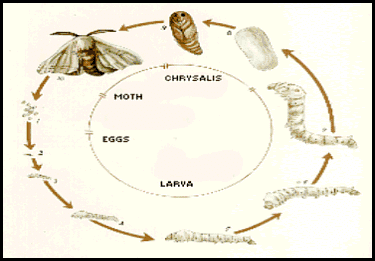Silk
Silk � In Old English, silk was sioloc. The name is
thought to have originated from the Greek seres, meaning the people from
Eastern Asia i.e. the Chinese. The term sericulture derives from this
Greek root.
Silk has a long and fascinating history, starting over 4000 years ago
with the development by the Chinese of the art of rearing silkworms to
make a textile fibre. Since that time silk has remained highly valued
for its luxurious qualities but, because its main uses have been in very
expensive apparel and other luxury goods, demand has been considerably
more variable than for many other fibres.
There are several species of silk producing worms but most of the
world�s silk results from the worm of the moth Bombyx mori which
lives exclusively on the leaves of Morus alba the white mulberry
tree. Other silkworms include the wild or semi-wild varieties, such as
Atlas, Eri, Tussah and Muga, which are found mainly in India and Asia.
The silkworms are reared in large numbers at silk farms, where
plantations of bush-like mulberry trees are cultivated to provide leaves
which are fed to the worms in special rearing rooms. From the day it
hatches to the time it stops feeding, a period of 25 to 30 days, the
worm gains in weight about 10,000 times. During this time it eats some
22g of leaves and converts more than 70% of its intake of nitrogenous
material into silk. To produce 1kg of raw silk about 6.25 kg of fresh
cocoons are necessary, while for raising 6.25 kg of cocoons about 104 kg
of mulberry leaves containing 26 kg of solid matter are required. On
average 75% of the fresh �green� cocoon, by weight is chrysalis. The
outer layer of floss and the inner layer are collected as silk waste and
used in spun silk manufacture. Wild silks such as Tussah are also
generally used for spun silk as the cocoons are seldom in a reelable
condition.

Tussah, a kind of wild silkworm, comes in two varieties monovoltine and
bivoltine. It lives and multiplies wherever oak trees or leaves of the
Mongolian oak, rubber trees or Chinese toon trees are available. There
is one main type of tussah silkworm, Antheraea pernyi, and one
general type of oak tree on which it feeds, Quercus serrata.
Tussah Moth
The Tussah chrysalis and cocoon are larger than those of the mulberry
silkworm, but the cocoon shell is thinner, has a lower layer ratio and
yields less silk. The Tussah cocoon is reddish-brown in colour, while
the mulberry cocoon is white. Tussah silk�s seracin or protein content,
is 13.3%, which is lower than that of mulberry silk. The fibroin, or
fibre itself, accounts for the remaining 86.7% and is composed of 15
amino acid residues.
Silk is a fairly strong fibre and although it does not compare with
nylon and polyester in this respect its strength makes it suitable for
use in sewing thread in high quality articles, particularly those made
from silk. Silk absorbs more moisture from the surrounding air than do
most of the synthetic fibres, and this property confers considerable
advantages; it prevents a clammy feeling where fabric is in contact with
the skin, since moisture can be absorbed without the fibre becoming
noticeably damp, and transmitted through the material and into the
atmosphere.
Silk has a fairly high natural resistance to creasing. Attempts to
improve on this and also to apply easy-care treatments have not been
very successful, as they impair the unique handle, or feel, of silk
which is one of its most valuable properties.
The environmental impact of silk processing is relatively minor in its
initial stages when compared to cotton or wool. The cocoons are cooked
to kill off the insects and then the fibre is washed in synthetic
detergents to remove most of the sericin (gum) in readiness for dyeing.>
Subsequent processing, through spinning, weaving, dyeing and finishing
have an impact on the environment similar to most of the other fibres.
Noise and dust is produced in weaving and a complex effluent with
variable BOD/COD, pH and solids content is produced in finishing.
|

